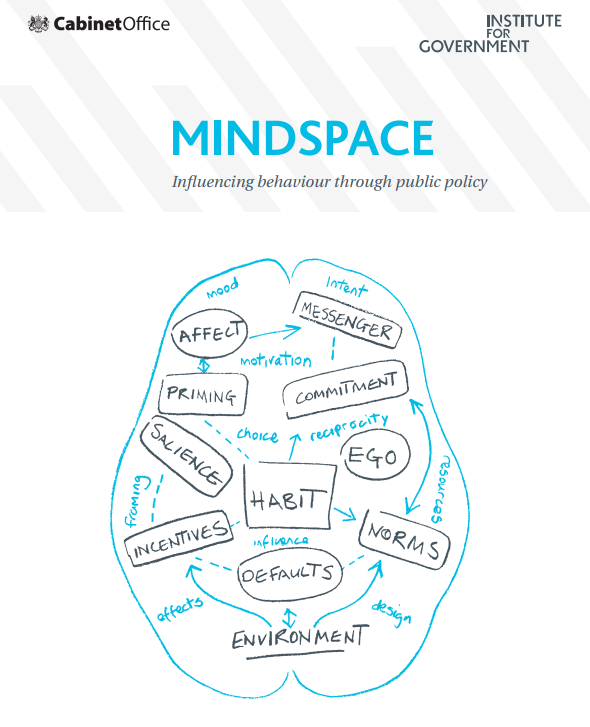Nine of the most robust (non-coercive) influences on our behaviour, captured in a simple mnemonic – MINDSPACE – which can be used as a quick checklist when making policy.
The vast majority of public policy aims to change or shape our behaviour. And policymakers have many ways of doing so. Most obviously, they can use “hard” instruments such as legislation and regulation to compel us to act in certain ways. These approaches are often very effective, but are costly and inappropriate in many instances. So government often turns to less coercive, and sometimes very effective, measures, such as incentives (e.g. excise duty) and information provision (e.g. public health guidance) – as well as sophisticated communications techniques.
Why, then, is there a need to change anything? Behavioural theory suggests two reasons.
First, the impact of existing tools such as incentives and information can be greatly enhanced by new evidence about how our behaviour is influenced (some of which has already been incorporated into government communications).
Second, there are new, and potentially more effective, ways government could shape behaviour.
Tools such as incentives and information are intended to change behaviour by “changing minds”. If we provide the carrots and sticks, alongside accurate information, people will weigh up the revised costs and benefits of their actions and respond accordingly. Unfortunately, evidence suggests that people do not always respond in this “perfectly rational‟ way.
In contrast, approaches based on “changing contexts” – the environment within which we make decisions and respond to cues – have the potential to bring about significant changes in behaviour at relatively low cost. Shaping policy more closely around our inbuilt responses to the world offers a potentially powerful way to improve individual wellbeing and social welfare.
With this in mind, this report sets out nine of the most robust (non-coercive) influences on our behaviour, captured in a simple mnemonic – MINDSPACE – which can be used as a quick checklist when making policy.

| Messenger | We are heavily influenced by who communicates information. |
| Incentives | Our responses to incentives are shaped by predictable mental shortcuts such as strongly avoiding losses. |
| Norms | We are strongly influenced by what others do. |
| Defaults | We “go with the flow” of pre-set options. |
| Salience | Our attention is drawn to what is novel and seems relevant to us. |
| Priming | Our acts are often influenced by sub-conscious cues. |
|
Affect |
Our emotional associations can powerfully shape our actions. |
| Commitments | We seek to be consistent with our public promises, and reciprocate acts. |
| Ego | We act in ways that make us feel better about ourselves. |
End of Preview

